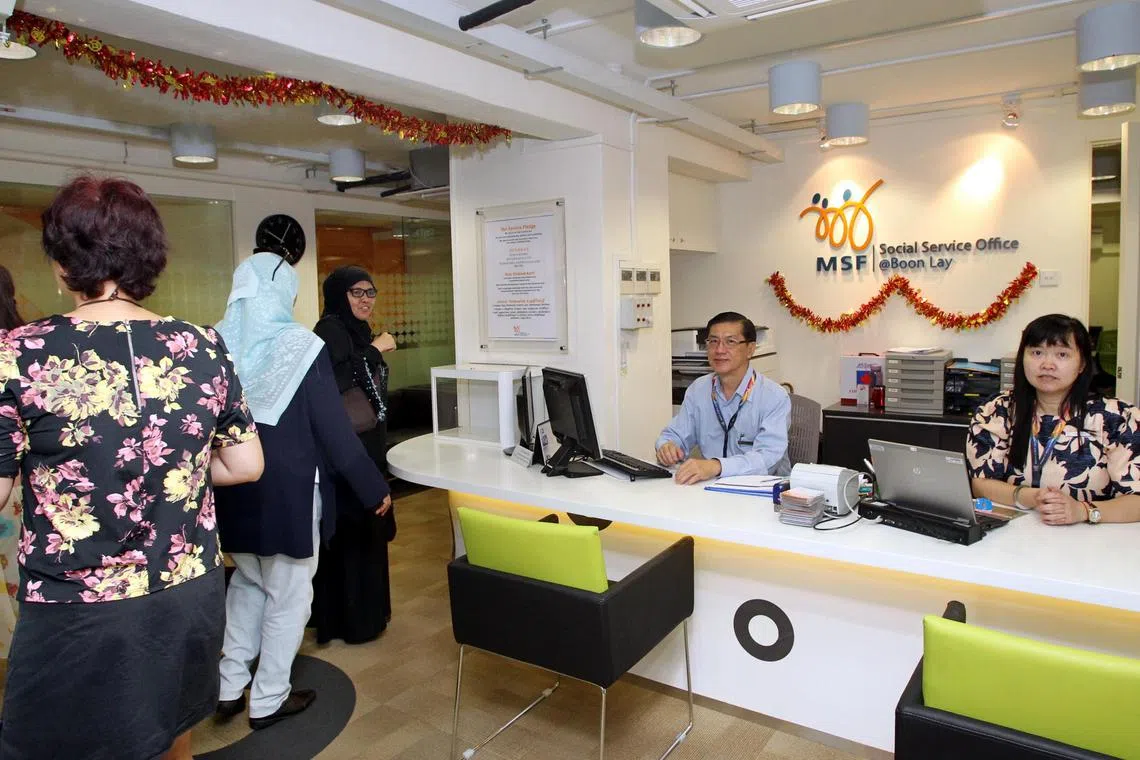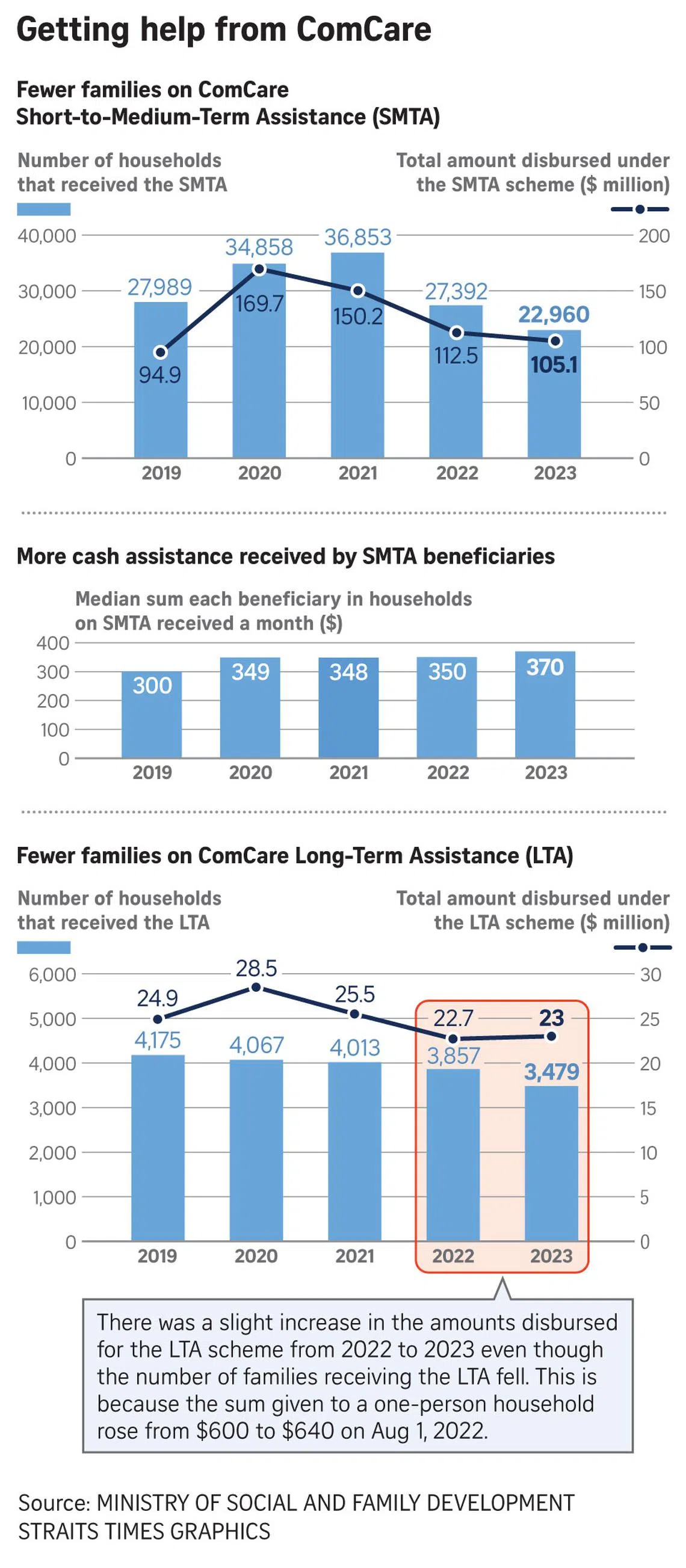Smaller share of lower-income families returned to getting temporary financial aid: MSF report
Sign up now: Get ST's newsletters delivered to your inbox

The trends reflect the post-Covid-19 economic recovery, where more people are employed, coupled with support from other government schemes.
PHOTO: LIANHE ZAOBAO
Follow topic:
SINGAPORE - A smaller proportion of lower-income families received help again to tide them over their financial difficulties, within three years of them leaving a government financial aid scheme.
About 54 per cent of families on ComCare Short-To-Medium-Term Assistance (SMTA) received another tranche of cash assistance within three years of leaving the scheme in 2020.
This is a drop from a return rate of 63 per cent of families whose aid ended in 2019.
This is the first time such data has been made public in the annual ComCare statistics, which were released by the Ministry of Social and Family Development (MSF) on Nov 19 in its Supporting Lower-Income Households Trends Report.
ComCare is the key social safety net for lower-income families in Singapore, and the SMTA scheme gives families temporary financial aid to cover the shortfall in their incomes to meet their basic living expenses.
A household is considered to be off the scheme when it stops getting aid for at least one month.
In 2023, fewer families received SMTA, and the total amount disbursed through the scheme also fell from $112.5 million in 2022 to $105.1 million in 2023.
The trends reflect the post-Covid-19 economic recovery, where more people are employed, coupled with the support Singaporeans get from other government schemes, said the report.
Families that returned to getting help from the SMTA scheme are more likely to have more dependants, family members who are medically unfit to work, or live in one- and two-room HDB rental flats, said the report.
The 41-page report outlined key trends in the ComCare schemes, and included data about the more than 9,000 families on the new ComLink+ scheme, which was announced in 2023.
ComLink+ gives low-income families financial incentives and other support if they work towards improving their lives, such as by holding on to a stable job and saving to buy a Housing Board flat.
An MSF spokeswoman said the ComLink+ scheme is one way the ministry is better supporting families that are more likely to need help from the SMTA scheme again, so they can be self-reliant.
In 2023, a total of 22,960 families were on SMTA, a 16 per cent fall from 27,392 families in 2022.
In fact, the number of households on the scheme in 2023 was the lowest in the past five years, falling from a peak of 36,853 in 2021 at the height of the Covid-19 pandemic, which affected the economy and jobs.
For the first time, the median amount that each beneficiary received from the SMTA scheme was also reflected in the report.
In 2023, the median sum for each beneficiary was $370 a month, up from $300 in 2019.
The increase in the sums given comes after regular reviews to ensure that the ComCare coverage remains adequate, the report said. A family can have more than one beneficiary for the scheme.
For example, if a family has four beneficiaries, and assuming that each receives the median sum of $370, the family gets a total of $1,480 a month.
The median length of aid given to families on the SMTA scheme was six months in 2023.
Social workers interviewed said many families that continue to need help face multiple and complex challenges, such as illnesses, caregiving responsibilities, addictions and other problems.
Mr Ian Peterson, Care Corner Singapore’s director of family and community services, said these problems may make it hard for those in such families to work consistently and earn a regular income.
Besides, many of them work in the gig economy or in jobs that offer little or no job security and benefits, adding to their financial instability, he said. The rising cost of living also adds to their financial strain.
Mr Firdaus D’Cruz, chief executive of Pertapis, said those who have lost their jobs suddenly may take a longer time to learn a new skill or move to a new sector that offers better job security.
The MSF spokeswoman told The Straits Times it does not set a maximum number of times families can get their SMTA aid renewed. “Clients are expected to take steps to improve their financial circumstances, such as taking action to seek employment,” she said.
Besides cash, families getting SMTA may get other help that is directly credited to relevant agencies, such as for HDB rental and utilities bills, to offset their household bills.
The amount given to families on the SMTA scheme depends on each family’s needs, income and other factors.
ComCare Long-Term Assistance Scheme
Besides SMTA, another ComCare scheme is Long-Term Assistance, for the destitute who are permanently unable to work because of old age or illness and have little or no family support.
The number of households receiving such aid fell by 10 per cent from 3,857 in 2022 to 3,479 in 2023, continuing a falling trend in the past five years, despite an ageing population.
This may be because more Singaporeans work for a longer period of time, younger seniors have more savings, and the Government’s social support for seniors has expanded in recent years, said the report.
Such support includes enhancements to the Silver Support Scheme, which gives seniors with low incomes during their working years, among other criteria, cash every quarter.

Seniors form the bulk of households on the Long-Term Assistance scheme, and this is because the elderly are more likely to be permanently unable to work, said the report.
A one-person household on the Long-Term Assistance scheme receives $640 a month, up from $600 previously.
Associate Professor Walter Theseira, an economist from the Singapore University of Social Sciences, said the introduction of policies such as the Silver Support Scheme and the Workfare Income Supplement (WIS) have substantially reduced retirement inadequacy for lower-income Singaporeans.
He said this could have led to the falling number of seniors receiving long-term aid. The WIS tops up the incomes and Central Provident Fund accounts of lower-wage workers.
Besides, a higher proportion of seniors today are better educated, and hence more held better paying jobs and have more money for their retirement, compared with those in the past, Prof Theseira added.


